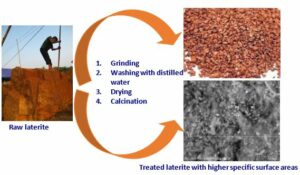

Purification of rainwater: an approach for drinking water production in countryside and rural areas in Vietnam
According to the United Nations, 2.2 billion of people living with lack of clean water, and 4.4 billion of people with limited access to clean water. By 2030, 60 nations seriously lack of clean water while 3.6 million deaths due to diseases related to water pollution. According to a recent report, about 20% of the population does not have access to clean water in Vietnam. Only 39 percent of rural individuals have access to clean water. Furthermore, most of these individuals must use water wells that tap into underground aquifers and rainwater to compensate for the lack of a clean water source at the surface. These two water sources need to be purified for household and drinking purposes.
In the framework of INOWASIA project, the research group from the Key Laboratory of Advanced Materials for Green Growth at Vietnam National University have developed an environmentally friendly and safe material from laterite naturally abundant in many areas in Vietnam by using thermal treatment process to remove impurities and increase the surface areas of the treated materials. The latter was then used as an adsorbent for the purification of rainwater to produce drinking water. The developed adsorbent was applied in a combination system of collecting, preserving, solar heating, and purifying rainwater as shown in the figure below.

The outcomes revealed that all the water quality parameters were below the limits of the national standard for drinking water (QCVN 01:2009/BYT), especially all the Coliform and E. coli bacteria from rainwater (due to contamination from roofs, water pipes and reservoirs) were safely removed by the system, implying that the combination of rainwater collecting, solar heating, and adsorption/purification system is suitable to produce drinking water in rural areas, helping inhabitants in countryside and rural areas overcome water shortage issue by using locally available materials and with a sustainable approach.
The findings in this research have been submitted to the Journal of Water Resources Development (Taylor & Francis).

For more info check the Hanoi University of Science website.
INOWASIA is an Erasmus + Capacity Building Higher Education project that promotes a joint action of 11 organisations across 5 countries (Cambodia, Laos, Vietnam, France and Spain) to train a new generation of water professionals in Southeast Asia. More info
Follow us @INOWASIA (Facebook & LinkedIn) #INOWASIA (Twitter)
This project has been funded with support from the European Commission. This publication reflects the views only of the author, and the Commission cannot be held responsible for any use which may be made of the information contained therein.
Project Number: 619225-EPP-1-2020-1-ES-EPPKA2-CBHE-JP
Let's Talk!
All Rights Reserved by INOWASIA 2021

